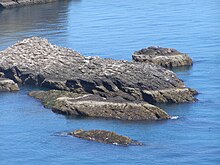Fowlsheugh

Fowlsheugh is a
Due to
Geology and topography

The sheer cliffs of Fowlsheugh are actually undercut in some places by erosive force of the North Sea wave action and associated strong marine winds, giving rise to cliff overhangs in numerous stretches of the blufftop trail. (Off shore winds commonly attain mean velocities of 80 kilometres per hour here, especially in winter months.) The underlying rock formation is known as Old Red Sandstone, which occurs from Dunnottar Castle five kilometres north to the town of Catterline seven kilometres south. This sandstone formation may be as thick as 2700 metres.
In places the fissured red-and-green-coloured sandstone is replaced by picturesque conglomerate with roundish stones varying in diameter from two to thirty centimetres (historically known as puddingstone in this region of Kincardineshire).[4] In other places more greenish volcanic extrusions are evident as harder veins within the sandstone bluffs.
Where the rock faces meet the North Sea, there are several sea caves accessible only by small boat. The deepest cave known locally as the “Gallery” intrudes a full hundred metres westward beneath the fertile barley fields high above. In the northern extremity of the Fowlsheugh is an offshore skerry named Craiglethy, and slightly further a skerry called Gull Craig. These lower lying rocky outcrops are an integral part of the Fowlsheugh Preserve, hosting seabird nests as well as a few harbour seals on Craiglethy, who can be seen hauling out or sunbathing on summer afternoons. Craiglethy is composed only of sandstone and volcanic material, any original overlying conglomerate material having been long eroded. There are also some volcanic sea stacks along the shoreline, vestiges of the harder rock formations surviving the erosion of surrounding softer rocks by millennia of wave action and salt spray.
History
Historically there has been human recognition of Fowlsheugh as a unique bird area for at least five centuries, culminating in its present-day designations of Important Bird Area (IBA), Special Protection Area (SPA) and SSSI (as noted above).
This historic interest has also translated into reasonably good bird counts over at least the last century. As a glimpse into Fowlsheugh in early Victorian times, James Anderson wrote:
"a remarkable rock of the conglomerate or plum pudding species called Fowls Heugh, about a mile long and two hundred feet high, quite perpendicular and in some places overhanging, often visited by sportsmen on account of innumerable sea fowl, of the kittiwake species, which resort to it in the breeding season; finding convenient places for depositing their eggs in the recesses formed by the vacant beds of pebbles"[5]
It is documented that in the 19th century not only did
About the year 1900 the Crown leased fishing rights at the base of Fowlsheugh to private interests, who proceeded to fish the North Sea close to the cliff faces using extensive systems of nets. The resulting entrainment of guillemots led to such great bird mortality, as well as to public outcry, that fishing lets were abandoned the following year. In 1920 fulmars arrived at Fowlsheugh to breed from St. Kilda.
Conservation status
International recognition of Fowlsheugh has been established primarily due to the large and productive seabird colonies present. On August 31, 1992 Special Protection Area (SPA) status was conferred with .EU code designation of UK9002271. The Fowlsheugh extent has been recorded as an area of only 10.15 hectares in size, making the seabird density one of the greatest in Europe.
Birdlife

In excess of 170,000 birds inhabit Fowlsheugh at the peak
As of 2005 about 18,000 breeding pairs of kittiwakes (Rissa tridactyla) return to Fowlsheugh each year, making their nests on some of the most vertical parts of the landscape from muck, seaweed and local grasses. This population level significantly decreased from the 1992 kittiwake count of 34,870 breeding pairs of this seabird. The 1992 value represented 1.1 percent of all North Atlantic breeding pairs of kittiwakes. This population level caused the site to qualify under Article 4.2 of the European Union Directive 79/409 by supporting populations of European importance of this migratory species. From the cliff overhangs above, it is easy to view the parent feeding of these chicks by regurgitation.
Under the 1992 bird count there were 40,140 breeding pairs of guillemot (Uria aalge), representing at least 1.8 percent of this breeding East Atlantic seabird population. Smaller numbers of other seabirds nest at Fowlsheugh, including Atlantic puffin (Fratercula Arctica), razorbill (Alca torda),
Marine life

In the North Sea waters at the base of the cliffs can be found certain marine mammals, including the
Terrestrial flora and fauna

On the clifftops are found a variety of flowering plants and grasses that offer additional biota infrastructure for the extensive butterfly populations resident at Fowlsheugh. Most of the blooming species flower in the period April through August. Representative flowering plants that occur at Fowlsheugh are:
Numerous species of butterfly are found[6] at Fowlsheugh, including:
- Aglais urticae, small tortoiseshell
- Argynnis aglaja, dark green fritillary
- Aricia artaxerxes, Biodiversity Action PlanPriority Species in the UK
- Coenonympha pamphilus, small heath
- Erebia aethiops, Scotch argus
- Hipparchia semele, Biodiversity Action PlanPriority Species in the UK (marked decline)
- Lycaena phlaeas, small copper
- Maniola jurtina, meadow brown
- Pieris brassicae, large white
Practical information
The Fowlsheugh Nature Reserve is most readily accessed on foot from the
References
- ^ "Fowlsheugh Nature Reserve, Aberdeenshire, Scotland".
- ^ Rob Hume, Fowlsheugh, Royal Society for Protection of Birds, summer 2006, vol 21, no. 2
- ^ C.Michael Hogan, Aberdeenshire Coastline, Lumina Press, Aberdeen, March, 2006
- ^ Archibald Watt, Highways and Byways Round Kincardineshire, Gourdas House Publishers, Aberdeen, (1985)
- ^ James Anderson, The Black Book of Kincardineshire (1843)
- ^ UK National Diversity Network (2006)

